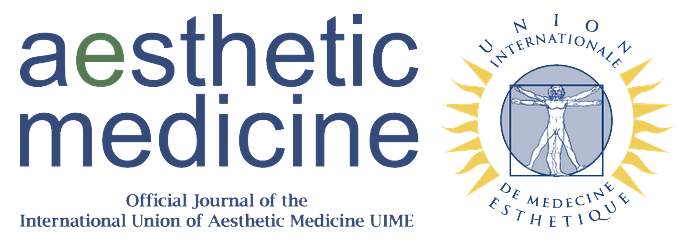Application of autologous fibroblasts in correcting involution-dystrophic skin changes
Keywords:
fibroblasts, platelet rich plasma, aiging, skinAbstract
This article delves into the clinical, instrumental and immunological studies of facial involutional-dystrophic skin changes in female patients of different ages with the development of a clinical method within their treatment called neofibrolifting. This method utilizes the transplant of autologous fibroblasts into the pretreated patient with platelet-rich plasma skin. Planning the proper treatment plan was based on the data of the transplanted cells properties as well as the instrumental and immunological studies of the patients’ dermis. Aging is a complex biological process of metabolic and structural-functional changes in the body, covering all human organs and tissues. Skin aging is part of the irreversible biological processes occurring in the body and is caused by genetic disorders, telomere shortening, resistance of cellular structures to oxidative damage, as well as aggressive environmental influences1. The properties and functions of the skin and its appendages deteriorate with age, the skin loses moisture, the ability to regenerate, becomes thinner, and the processes of keratinization, pigmentation, blood circulation, collagen synthesis, etc.are disrupted2,3. There is an accumulation of data on the significant involvement of the involution of the immune system in overall skin aging, which is generally defined as the process of immunosenescence4,5. This manifests through mechanisms known as age-related disorders in the compartments of hematopoietic stem and multipotent stromal cells with the inhibition of hematopoiesis and disorders in the regulation of immunoneuroendocrine6,7. There is a shift of cellular cooperative mechanisms towards the formation of chronic inflammations with the increased production of pro-inflammatory cytokines by adaptive and innate immune cells, which cause the appearance of a large number of senescent and terminally differentiated cells that are not able to perform the necessary functions8. Immunosenescent atrophic and dystrophic phenomena in the skin are manifested by a pronounced decrease in the number of dermal fibroblasts with the inhibition of their functional activity, which also negatively affects the condition of keratinocytes. As a result, the normal process of renewal of dermal fibroblasts and keratinocytes, the formation of the intercellular matrix, is disrupted, which primarily causes the appearance of noticeable involutional signs9-11.
References
Shah AR, Kennedy PM. The aging face. Med Clin North Am. 2018; 102(6):1041-54.
Schwartz E, Cruickshank FA, Christensen CC, Perlish JS, Lebwohl M. Collagen alterations in chronically sun-damaged human skin. Photochem Photobiol. 1993; 58(6):841-4.
Bonte F, Girard D, Archambault JC, Desmouliere A. Skin changes during ageing. Subcell Biochem. 2019; 91:249-80.
Kabashima K, Honda T, Ginhoux F, Egawa G. The immunological anatomy of the skin. Nat Rev Immunol. 2019; 19(1):19-30.
Nguyen J, Duong H. Anatomy, shoulder and upper limb, veins. In: StatPearls [Internet]. Treasure Island (FL): StatPearls Publishing; 2023 Jan.
Castro MCR, Ramos-E-Silva M. Cutaneous infections in the mature patient. Clin Dermatol. 2018; 36(2):188-96.
Chambers ES, Vukmanovic-Stejic M. Skin barrier immunity and ageing. Immunology. 2020; 160(2):116-25.
Takamura S. Niches for the long-term maintenance of tissue-resident memory T сells. Front Immunol. 2018; 9:1214.
Bonte F, Girard D, Archambault JC, Desmouliere A. Skin changes during ageing. Subcell Biochem. 2019; 91:249-80.
Sarbacher CA, Halper JT. Connective tissue and age-related diseases. Subcell Biochem. 2019; 91:281-310.
Shin JW, Kwon SH, Choi JY, et al. Molecular mechanisms of dermal aging and antiaging approaches. Int J Mol Sci. 2019; 20(9):2126.
Downloads
Published
Issue
Section
License
Copyright (c) 2023 Volodymyr Tsepkolenko, Hanna Tsepkolenko

This work is licensed under a Creative Commons Attribution-NonCommercial 4.0 International License.
This is an Open Access article distributed under the terms of the Creative Commons Attribution License (https://creativecommons.org/licenses/by-nc/4.0) which permits unrestricted use, distribution, and reproduction in any medium, provided the original work is properly cited.
Transfer of Copyright and Permission to Reproduce Parts of Published Papers.
Authors retain the copyright for their published work. No formal permission will be required to reproduce parts (tables or illustrations) of published papers, provided the source is quoted appropriately and reproduction has no commercial intent. Reproductions with commercial intent will require written permission and payment of royalties.

This work is licensed under a Creative Commons Attribution-NonCommercial 4.0 International License.





